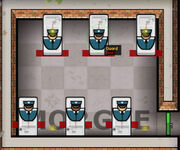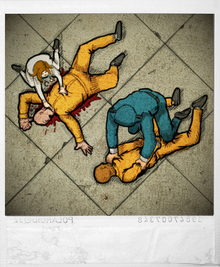
Several dead Guards in a morgue
Death, like in real life, is an inevitability in-game dependent on how well you safeguard the entities in your prison. The entities most likely to die in your prison are usually your guards and your prisoners as it is these entities that are most susceptible to violence, a common cause of death in Prison Architect.
Guards of all types will naturally put themselves in the line of attack in an attempt to subdue misbehaving prisoners. Guards can easily be knocked unconscious or even killed by prisoners, especially those with violent traits and reputations. It is wise to equip your guard with body armour and tasers to reduce the likelihood of guard deaths.
As aforementioned, prisoners with violent traits and reputations will initiate physical conflict frequently. It is often found that prisoners who are in a higher security category (E.G Max, Supermax)are more likely to possess ‘lethal’ traits and thus will attempt to kill those whom they fight. Prisoners that are considered ‘low risk’ are far less likely to possess these traits. Most conflicts they engage in will usually end when the opposing entity is knocked unconscious. Conflicts involving higher risk prisoners will usually only end when the opposing entity is killed.
Causes of Death[]

Realistically, violence is not the only cause of death. There are many other ways that death can occur in your prison. These are detailed below.
- Fire - any entity in close vicinity to open flames will burn until they eventually die. Fires are often started by malfunctioning cookers, power station explosions or prisoners with lighters.
- Virus - prisoners are susceptible to illness whilst in your prison. A prisoner may die if left untreated.
- Bleeding - prisoners operating workshop saws are at risk of sustaining serious injuries. As such, they will bleed out and die unless treated immediately.
- Overdose - prisoners may abuse drugs or narcotics if they are in possession of them. Overdosed prisoners will be highlighted to the player in-game and will die if they are not treated by a doctor or paramedic.
- Execution - a legalized cause of death. Inmates on death row that are found guilty of their crimes will be executed via electric chair.
- Violence - some entities can inflict violence on one another, which will decrease the target's health. Some fights will end if one party surrenders or is knocked unconscious, but some assailants will not stop until they have killed their target.
- Prisoner Violence - prisoners are the only entity in your prison that will initiate a conflict. Prisoners can beat other entities to death with a number of weapons, tools or even their bare fists. Prisoners can also shoot and kill entities if they acquire a firearm. These can be stolen from the armoury or obtained after an armed security staff member drops theirs.
- Staff & Emergency Service Violence - guards will subdue prisoners that are engaging in misconduct. They will do this with either the use of their batons, fists or tasers (if they have them). Armed Guards will predominantly focus on the use of their firearm - especially if freefire is turned on. Freefire authorizes armed security staff members to use lethal force against misbehaving prisoners. This often results in the accumulation of prisoner deaths. Guard dogs will maul misbehaving prisoners unconscious; if a prisoner kills a dog handler his dog will likely kill the prisoner in revenge. Unlike guards, Snipers will initiate deadly force even when Freefire is turned off and their lives are not in danger, shooting escaping prisoners dead from their Guard Towers. Several Emergency Services may also injure or kill inmates, including Riot Guards, Elite Ops and the National Guard.
- Warden Violence- in Warden Mode, it is possible to beat, taze, or shoot prisoners while playing as the Warden. This is only permitted as a form of self-defense, and the player cannot initiate a fight while playing as the Warden.
- Barbed Wire - a defensive measure to prevent prisoner escapes via the scaling of walls. Prisoners that climb on a wall lined with barbed wire will suffer from injury. Barbed Wire has the potential to kill prisoners, especially those who are already injured before they attempt to climb.
- Exposure - If a prisoner is exposed to temperatures below zero, they will receive the 'Exposure' status effect. Upon reach maximum intensity, the prisoner dies. Their cause of death will be 'Froze to death'.
- Starvation - If a prisoner receives no food at all, they will get the 'Starvation' status effect. Upon reaching maximum intensity, this will slowly take away the prisoner's health, becoming unconscious and eventually dead. Their cause of death will be 'Starved to death'.
NOTE: Guards will never attack with the intent to kill. All guard types will desist their attack on misbehaving prisoners when they either surrender, desist, are knocked unconscious or are killed. The only circumstance in which a guard will kill with intent is if a prisoner has a ‘cop killer’ trait. Guards may be unable to restrain themselves in these situations. Likewise, if a handler is killed by a prisoner then their dogs may maul that same prisoner to death in an act of vengeance.
Corpses will either temporarily be put to rest on morgue slabs in morgues or escorted to a hearse that will arrive on your prison's main road. Hearses will remove dead bodies from your prison.
Consequences[]
Deaths in your prison will only carry a consequence if certain map settings are activated:
- STAFF NEEDS ACTIVE - If a staff member, e.g. a guard, dies on-site, the staff morale will heavily deplete. Multiple staff deaths will ultimately lead to a staff strike.
- FAILURE CONDITIONS - If there are too many prisoner deaths, you will be cautioned or later fired for Criminal Negligence. If there are too many warden deaths, you will be cautioned and later fired if another warden is killed after the warning is issued. If you wrongfully execute a death row inmate who is later found to be innocent of his crimes, or whose clemency rating is above the state-approved level you will be cautioned and later fired.
Tips, Tricks, and Trivia[]
Prisoners with reputations such as 'snitch', 'ex-law enforcement', 'federal witness' or 'ex-prison guard' will often be immediately be marked for death. Move these prisoners to Protective Custody.
